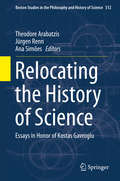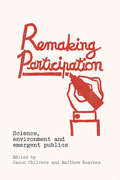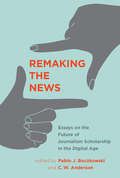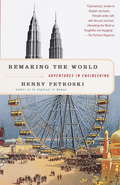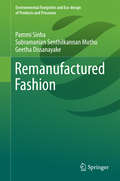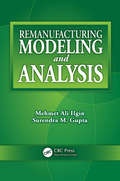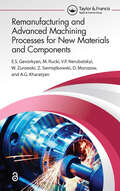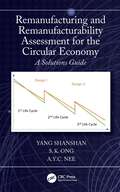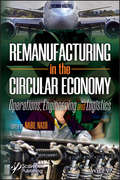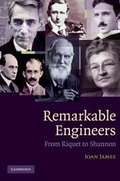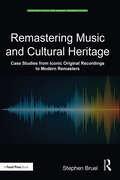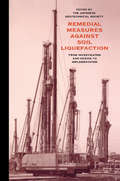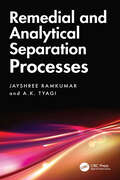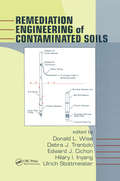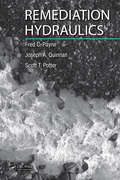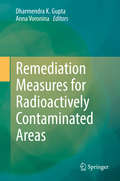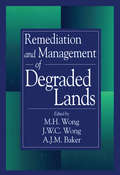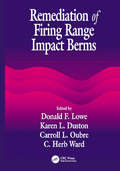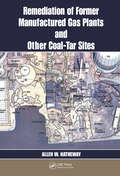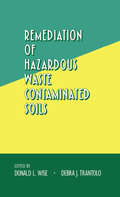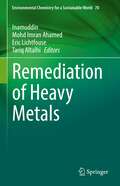- Table View
- List View
Relocating the History of Science
by Jürgen Renn Theodore Arabatzis Ana SimõesThis volume is put together in honor of a distinguished historian of science, Kostas Gavroglu, whose work has won international acclaim, and has been pivotal in establishing the discipline of history of science in Greece, its consolidation in other countries of the European Periphery, and the constructive dialogue of these emerging communities with an extended community of international scholars. The papers in the volume reflect Gavroglu's broad range of intellectual interests and touch upon significant themes in recent history and philosophy of science. They include topics in the history of modern physical sciences, science and technology in the European periphery, integrated history and philosophy of science, historiographical considerations, and intersections with the history of mathematics, technology and contemporary issues. They are authored by eminent scholars whose academic and personal trajectories crossed with Gavroglu's. The book will interest historians and philosophers of science and technology alike, as well as science studies scholars, and generally readers interested in the role of the sciences in the past in various geographical contexts.
Reluctant Genius: Alexander Graham Bell and the Passion for Invention
by Charlotte GrayThe popular image of Alexander Graham Bell is that of an elderly American patriarch, memorable only for his paunch, his Santa Claus beard, and the invention of the telephone. In this magisterial reassessment based on thorough new research, acclaimed biographer Charlotte Gray reveals Bell’s wide-ranging passion for invention and delves into the private life that supported his genius. The child of a speech therapist and a deaf mother, and possessed of superbly acute hearing, Bell developed an early interest in sound. His understanding of how sound waves might relate to electrical waves enabled him to invent the "talking telegraph” be- fore his rivals, even as he undertook a tempestuous courtship of the woman who would become his wife and mainstay. In an intensely competitive age, Bell seemed to shun fame and fortune. Yet many of his innovations--electric heating, using light to transmit sound, electronic mail, composting toilets, the artificial lung--were far ahead of their time. His pioneering ideas about sound, flight, genetics, and even the engineering of complex structures such as stadium roofs still resonate today. This is an essential portrait of an American giant whose innovations revolutionized the modern world.
Remaking Housing Policy: An International Study
by David ClaphamBreaking the country-specific boundaries of traditional housing policy books, Remaking Housing Policy is the first introductory housing policy textbook designed to be used by students all around the world. Starting from first principles, readers are guided through the objectives behind government housing policy interventions, the tools and mechanisms deployed and the outcomes of the policy decisions. A range of international case studies from Europe, Asia, Africa and the Americas illustrate the book’s general principles and demonstrate how different regimes influence policy. The rise of the neo-classical discourse of market primacy in housing has left many countries with an inappropriate mix of state and market processes with major interventions that do not achieve what they were intended to do. Remaking Housing Policy goes back to basics to show what works and what doesn’t and how policy can be improved for the future. Remaking Housing Policy provides readers with a comprehensive introduction to the objectives and mechanisms of social housing. This innovative international textbook will be suitable for academics, housing students and those on related courses across geography, planning, property and urban studies.
Remaking Participation: Science, Environment and Emergent Publics
by Matthew Kearnes Jason ChilversChanging relations between science and democracy – and controversies over issues such as climate change, energy transitions, genetically modified organisms and smart technologies – have led to a rapid rise in new forms of public participation and citizen engagement. While most existing approaches adopt fixed meanings of ‘participation’ and are consumed by questions of method or critiquing the possible limits of democratic engagement, this book offers new insights that rethink public engagements with science, innovation and environmental issues as diverse, emergent and in the making. Bringing together leading scholars on science and democracy, working between science and technology studies, political theory, geography, sociology and anthropology, the volume develops relational and co-productionist approaches to studying and intervening in spaces of participation. New empirical insights into the making, construction, circulation and effects of participation across cultures are illustrated through examples ranging from climate change and energy to nanotechnology and mundane technologies, from institutionalised deliberative processes to citizen-led innovation and activism, and from the global north to global south. This new way of seeing participation in science and democracy opens up alternative paths for reconfiguring and remaking participation in more experimental, reflexive, anticipatory and responsible ways. This ground-breaking book is essential reading for scholars and students of participation across the critical social sciences and beyond, as well as those seeking to build more transformative participatory practices.
Remaking the News: Essays on the Future of Journalism Scholarship in the Digital Age (Inside Technology)
by C. W. Anderson Pablo BoczkowskiLeading scholars chart the future of studies on technology and journalism in the digital age.The use of digital technology has transformed the way news is produced, distributed, and received. Just as media organizations and journalists have realized that technology is a central and indispensable part of their enterprise, scholars of journalism have shifted their focus to the role of technology. In Remaking the News, leading scholars chart the future of studies on technology and journalism in the digital age. These ongoing changes in journalism invite scholars to rethink how they approach this dynamic field of inquiry. The contributors consider theoretical and methodological issues; concepts from the social science canon that can help make sense of journalism; the occupational culture and practice of journalism; and major gaps in current scholarship on the news: analyses of inequality, history, and failure.ContributorsMike Ananny, C. W. Anderson, Rodney Benson, Pablo J. Boczkowski, Michael X. Delli Carpini, Mark Deuze, William H. Dutton, Matthew Hindman, Seth C. Lewis, Eugenia Mitchelstein, W. Russell Neuman, Rasmus Kleis Nielsen, Zizi Papacharissi, Victor Pickard, Mirjam Prenger, Sue Robinson, Michael Schudson, Jane B. Singer, Natalie (Talia) Jomini Stroud, Karin Wahl-Jorgensen, Rodrigo Zamith
Remaking the World: Adventures in Engineering
by Henry PetroskiA selection of 19 articles (most) first published in "American Scientist" by the engineer/author notable for his interest in giving engineers a broader sense of their field, and giving the general public an appreciation of the art and science of engineering. Among Petroski's previous works are "The Evolution of Useful Things" and "To Engineer Is Human". Annotation c. by Book News, Inc. , Portland, Or.
Remanufactured Fashion
by Pammi Sinha Subramanian Senthilkannan Muthu Geetha DissanayakeThis book highlights the concept and applications of Remanufactured Fashion. The first book on this subject, it covers reverse logistics, exemplars, and case studies of remanufactured fashion design. Textile waste is a major issue for all countries, and converting that waste into useful products offers a sensible solution. Remanufactured Fashion is one such sustainable waste management strategy. It involves the conversion of discarded garments into useful retail products, without which they would be dumped at landfills, posing a number of environmental issues. Remanufacturing recovers a product's inherent value once that product no longer fulfills the user's desired needs. The application and use of discarded clothing in remanufacturing processes could greatly reduce the percentage of clothing waste (and mitigate related waste management issues), while also contributing to resource conservation. There has been scant research investigating what is actually involved in the fashion remanufacturing process and how the process could be up-scaled to the mass market in order to achieve greater environmental gains. This book addresses that gap in the literature and examines all aspects pertaining to the concept and applications of Remanufactured Fashion.
Remanufacturing Modeling and Analysis
by Surendra M. Gupta Mehmet Ali IlginNew, Now, Next. Consumers' ever growing appetite to acquire new products and their short courtship with them has kept manufacturers busy not only expending resources at an alarming rate, but also depleting these resources and giving rise to waste and pollution at a correspondingly increasing and disturbing rate. Traditional manufacturing methods th
Remanufacturing and Advanced Machining Processes for New Materials and Components
by M. Rucki Z. Siemiątkowski Е.S. Gevorkyan V.P. Nerubatskyi W. Żurowski D. Morozow A.G. KharatyanRemanufacturing and Advanced Machining Processes for Materials and Components presents current and emerging techniques for machining of new materials and restoration of components, as well as surface engineering methods aimed at prolonging the life of industrial systems. It examines contemporary machining processes for new materials, methods of protection and restoration of components, and smart machining processes. • Details a variety of advanced machining processes, new materials joining techniques, and methods to increase machining accuracy • Presents innovative methods for protection and restoration of components primarily from the perspective of remanufacturing and protective surface engineering • Discusses smart machining processes, including computer-integrated manufacturing and rapid prototyping, and smart materials • Provides a comprehensive summary of state-of-the-art in every section and a description of manufacturing methods • Describes the applications in recovery and enhancing purposes and identifies contemporary trends in industrial practice, emphasizing resource savings and performance prolongation for components and engineering systems The book is aimed at a range of readers, including graduate-level students, researchers, and engineers in mechanical, materials, and manufacturing engineering, especially those focused on resource savings, renovation, and failure prevention of components in engineering systems.
Remanufacturing and Remanufacturability Assessment for the Circular Economy: A Solutions Guide
by A.Y.C. Nee Yang Shanshan S. K. OngThis book presents decision support tools that can be used in the early design stage to analyze the feasibility of a product and its components for remanufacturing. It also covers how to design a product specifically for remanufacturing and offers supporting case studies. This is a comprehensive solutions guide for remanufacturing decision-making. The book illustrates an approach that can be used at the product End-of-Life (EOL) stage to generate optimized recovery plans for the returned products. Opportunities for Industry 4.0 to support remanufacturing along with case studies are included to showcase the decision-making tools. Remanufacturing and Remanufacturability Assessment for the Circular Economy: A Solutions Guide will be of interest to practitioners, business professionals, and researchers that work in the industrial and manufacturing sectors. Those involved with supply chain management and advanced technologies associated with Industry 4.0, sustainability, and integrated techniques of circular supply chains will also find this book very useful.
Remanufacturing in the Circular Economy: Operations, Engineering and Logistics
by Nabil NasrEconomic growth and rising levels of consumption in developing and developed countries has been observed as being deeply coupled with natural resource usage and material consumption. The increasing need for natural resources has raised concerns regarding issues such as resource scarcity, undesirable environmental impacts due to material extraction, primary production, and suboptimal product disposal, and social or political tensions. Product End-of-Life (EoL) options, such as reusing or recycling, attempt to limit or reduce the amount of waste sent to a landfill, providing strategic means to decouple the link between economic growth and resource usage. These EoL options have the potential to close material loops, further utilizing wastes as resources, reducing environmental impacts, conserving natural resources, reducing material prices, and providing job opportunities in developing countries.Remanufacturing, on the other hand, is a unique EoL option due to increasing the number of life cycles of a product before final disposal. First, recurring environmental benefits, such as emission and raw material extraction avoidance are obtained with each additional product life cycle. Second, individual resource efficiency yields increase through product remanufacture. Resource efficiency or, using more with less will continue to compound with each additional life cycle. Third, recirculating products decreases the demand and dependency for primary resource production, further closing the material loop and creating a more circular economy. In addition, remanufacturing can initiate more preferable EoL options such as recovery, recycling, and waste reduction. While remanufacturing offers numerous benefits, there is significant lack of literature and books covering the fundamentals of operations, technologies and business models. The proposed book will provide in-depth coverage of remanufacturing fundamentals and its strong link to circular economy and resource efficiency.
Remarkable Engineers
by Ioan JamesJames (mathematics, U. of Oxford, UK) documents the life stories of 51 engineers from the seventeenth to the twentieth centuries who pioneered the design and building of railways, bridges, airplanes, communications, radio and television, automobiles, electronics, and were involved in space research. He emphasizes their life stories over their achievements, and arranges profiles chronologically, which feature engineers from Western and Eastern Europe and the US, and include Pierre-Paul Riquet, Thomas Telford, John Rennie, Richard Trevithick, George Stephenson, Charles Babbage, John Ericsson, Gustave Eiffel, Thomas Edison, Alexander Graham Bell, Hertha Ayrton, Nikola Tesla, Heinrich Hertz, Wilbur and Orville Wright, Wernher von Braun, and Edith Clarke. B&w portraits and photos are included. No index is provided. Annotation ©2010 Book News, Inc. , Portland, OR (booknews. com)
Remarkable Natural Material Surfaces and Their Engineering Potential
by Michelle LeeThis book explores a collection of natural surfaces, their scientific characteristics and their unique engineering potential - demonstrating that engineering applications can be found in unexpected places. The surfaces covered range from botanical ones, like rice and lotus leaves, to insect surfaces, like butterfly and dragonfly wings. The variety of surfaces and numerous engineering potentials described show how biomimicry can be utilized to solve countless real‐world problems.
Remastering Music and Cultural Heritage: Case Studies from Iconic Original Recordings to Modern Remasters (Perspectives on Music Production)
by Stephen BruelRemastering Music and Cultural Heritage presents a detailed account of the culture and practice of remastering music recordings. By investigating the production processes and the social, nostalgic and technological components of remastering practice, the book demonstrates the application of these techniques to iconic recordings by artists including The Beatles, Elton John and Oasis. Through comprehensive interviews with music production professionals directly involved in both the original productions and remastered releases of these iconic recordings – and detailed digital audio analysis – this book offers an extensive insight into music production and remastering practice. Readers learn about the music production techniques behind creating some of the most well-recognised and loved albums of all time, as well as the processes used to create the remasters, to help guide their own projects. Remastering Music and Cultural Heritage is essential reading for students and teachers of music production, professional practitioners and musicians.
Remedial Measures Against Soil Liquefaction: from Investigation and Design to Implementation
by THE JAPANESE GEOTECHNICAL SOCIETYThis text was compiled by the Japanese Geotechnical Society. It describes everything about the remedial measures against liquefaction currently used in Japan following research projects after the Niigata earthquake of 1964.
Remedial and Analytical Separation Processes
by Jayshree Ramkumar A.K. TyagiThis book describes a comprehensive, integrated view of separation science backed by discussions about simple extraction and partition processes to give a better understanding of advanced techniques like chromatography and membrane separations. It paves the way for an understanding of the fundamental physical and chemical phenomena involved in separations and a concise overview of transport reactions. A chapter dedicated to phytoremediation gives an understanding of the various processes involved in the bioremediation of environmental media.Features: Provides synchronous aspects of the separation process for remediation, including phytoremediation and analysis using chromatography Addresses basic separation techniques for water solutions Discusses mechanistic views of various separation processes Includes the mechanism of separation using membranes and sorbents Helps the reader understand the connection between the different discrete separation processes This book is aimed at senior undergraduate and graduate students in environmental engineering and analytical chemistry.
Remediation Engineering of Contaminated Soils (Environmental Science & Pollution)
by Donald L. WiseOffers thorough coverage of the remediation of soils contaminated by hazardous wastes, including materials, analytical techniques, cleanup design and methodology, characterization of geomedia, monitoring of contaminants in the subsurface, and waste containment. Cites specific case studies in hydrocarbon remediation that offer a concise overview of possible technological approaches.
Remediation Hydraulics
by Fred C. Payne Joseph A. Quinnan Scott T. PotterIn situ treatments involving the arrangement of contact between prospective reactants in complex porous media require a refined understanding of solute migration. However, the tools and methods used to predict and control fluid movement in the subsurface need significant improvement. Practitioners and regulators must develop novel methods to
Remediation Manual for Contaminated Sites
by David L. RussellBased on the author’s more than 40 years of experience working on environmental projects, Remediation Manual for Contaminated Sites provides a practical guide to environmental remediation and cleanups. It presents a broad overview of the environmental remediation process, distilled into what one needs to know to evaluate a specific challenge or solve a remediation problem. The text offers guidance on tasks that range from managing consultants and contractors to gathering data, selecting a suitable remediation technology, and calculating remediation costs. This new edition is updated throughout, includes five new chapters, and provides a more global coverage.• This book includes remediation strategies for a variety of contaminants and examines a wide range of technologies for the remediation of water and soil, including excavation, wells, drainage, soil venting, vapor stripping, incineration, bioremediation, containment, solidification, vitrification, and phytoremediation.• Written as a down‑to‑earth reference for professionals faced with the challenges of remediating a contaminated site, this book is also useful as a primer for students and those new to the field. It includes numerous figures, photographs, tables, and helpful checklists.• This new edition adds five all‑new chapters. It presents a more global approach and practical examples from around the world.
Remediation Measures for Radioactively Contaminated Areas
by Dharmendra K. Gupta Anna VoroninaThis book offers extensive and comprehensive knowledge to the researchers and academicians who are working on decontamination of radioactively contaminated areas. Remediation strategies for contaminated sites are provided. Readers who will find this book useful include professionals specializing in radioecology, safe disposal of radioactive waste, as well as decontamination, remediation legacies and impact of radioactive waste material on the environment. The chapters give a broad overview and reviews of a number of original publications on remediation strategies that were explored after the Chernobyl and Fukushima Nuclear Power plant accidents. Useful case studies are provided that explore the latest technological developments and future trends for affected area decontamination.
Remediation and Management of Degraded Lands
by MH WongRemediation and Management of Degraded Lands presents the program of the first International Conference on the Remediation and Management of Degraded Lands. This collection reviews the extent of resource debasement and offers solutions for their restoration. The 14-part first section deals with mine management and rehabilitation. Topics include the devastating results of open-cut mining, open-pit mining, lignite surface mining and acid mining. Despite such ruin, the articles reveal the possibilities for reclamation. Part two devotes nine chapters to the management of derelict lands. Reforestation, soil fertility prognosis, and the uses of nitrogen are just a few of the covered subjects. This portion of the book pays special attention to the successful results of remediation in China and Hong Kong. The final division addresses soil contamination and reclamation. There are eleven chapters on subjects that include the single and interactive effects of aluminum, the effectiveness of EDTA/HCI and the value of pig-on-litter compost as a tool for edible crop growth. These and other innovative techniques make Remediation and Management of Degraded Lands a valuable addition to any environmental library.
Remediation of Firing Range Impact Berms
by C. H. WardA part of the continuing effort to provide innovative in situ remediation techniques, Remediation of Firing-Range Impact Berms presents the results of a soil washing and leaching project. The demonstration set as its primary objective providing reliable, detailed performance data to evaluate the feasibility and cost of implementing a full-scale sys
Remediation of Former Manufactured Gas Plants and Other Coal-Tar Sites
by Allen W. HathewayWinner of the 2013 Claire P. Holdredge Awardee for Remediation of Former Manufactured Gas Plants and Other Coal-Tar Sites.This award, first established in 1962 by the Association of Environmental and Engineering Geologists, is named in honor of Claire P. Holdredge, a founding member and the first President of the Association. The award is
Remediation of Hazardous Waste Contaminated Soils
by DonaldL. Wise""This unique, single-source reference offers a thorough treatment of the remediation of soils contaminated by hazardous wastes and the scientific and engineering issues that must be addressed in creating practical solutions for their reclamation.
Remediation of Heavy Metals (Environmental Chemistry for a Sustainable World #70)
by Eric Lichtfouse Inamuddin Mohd Imran Ahamed Tariq AltalhiThe book presents recent remediation techniques for heavy metal contamination in wastewater, with a focus on recently-developed and sustainable materials such as metal oxides and their composites, two-dimensional materials, organic-inorganic ion exchange materials, nanomaterials, bagasse, and olive-oil waste chelating materials. Chapters also describe the analysis of heavy metals, membranes for water treatment, sources and impact of heavy metals and opportunities and challenges in heavy metal remediation.
